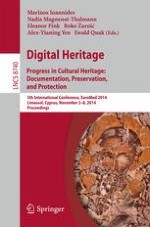2014 | Buch
Digital Heritage. Progress in Cultural Heritage: Documentation, Preservation, and Protection
5th International Conference, EuroMed 2014, Limassol, Cyprus, November 3-8, 2014. Proceedings
herausgegeben von: Marinos Ioannides, Nadia Magnenat-Thalmann, Eleanor Fink, Roko Žarnić, Alex-Yianing Yen, Ewald Quak
Verlag: Springer International Publishing
Buchreihe : Lecture Notes in Computer Science
